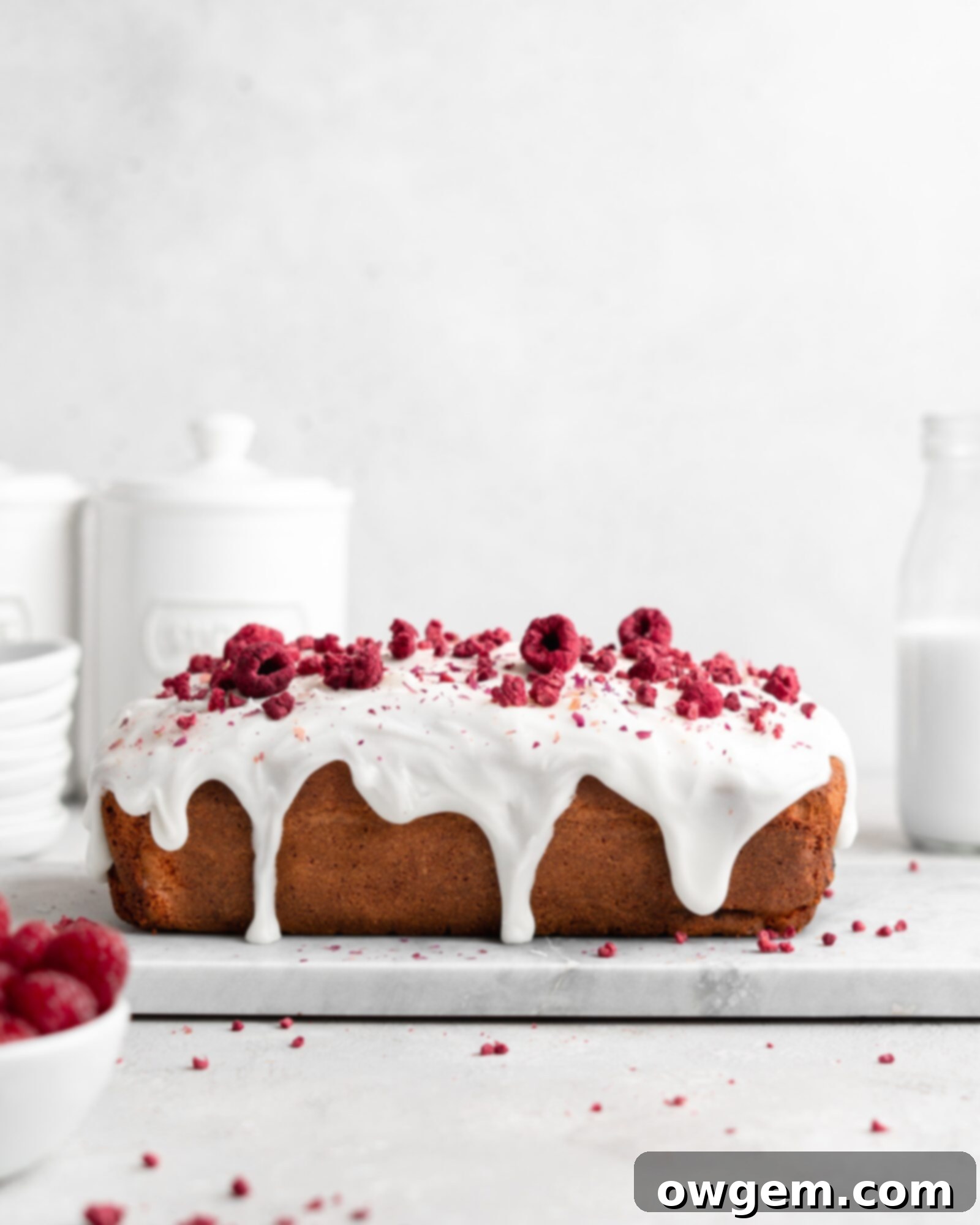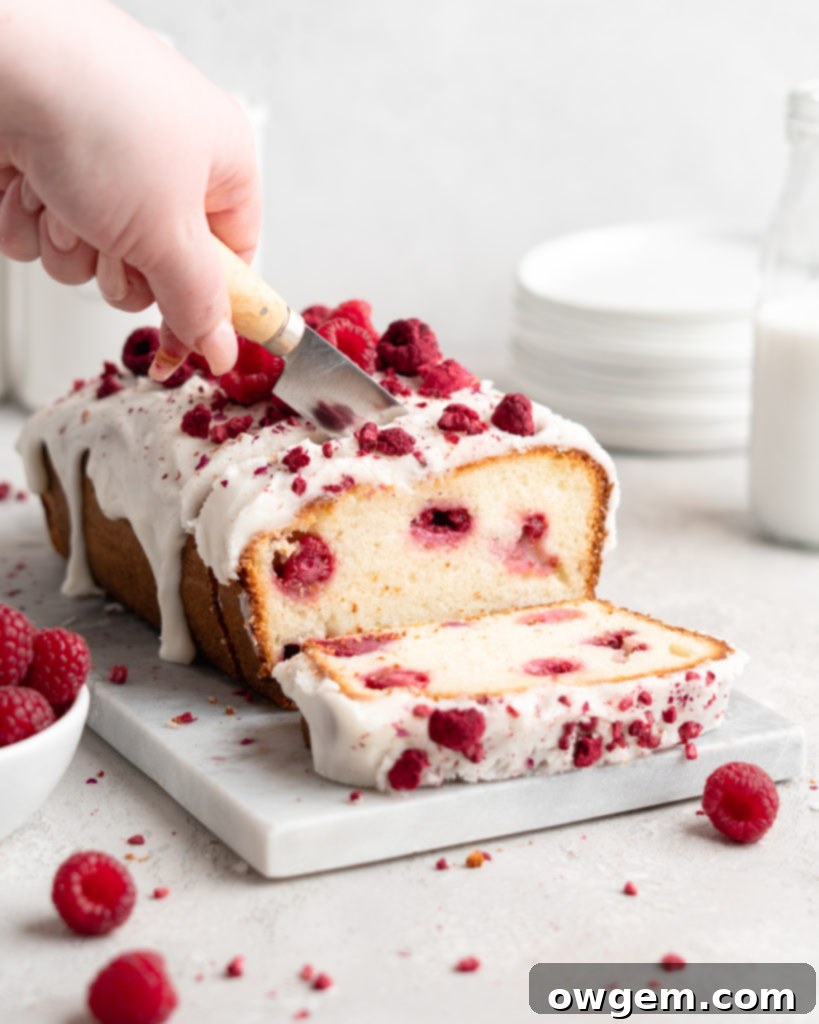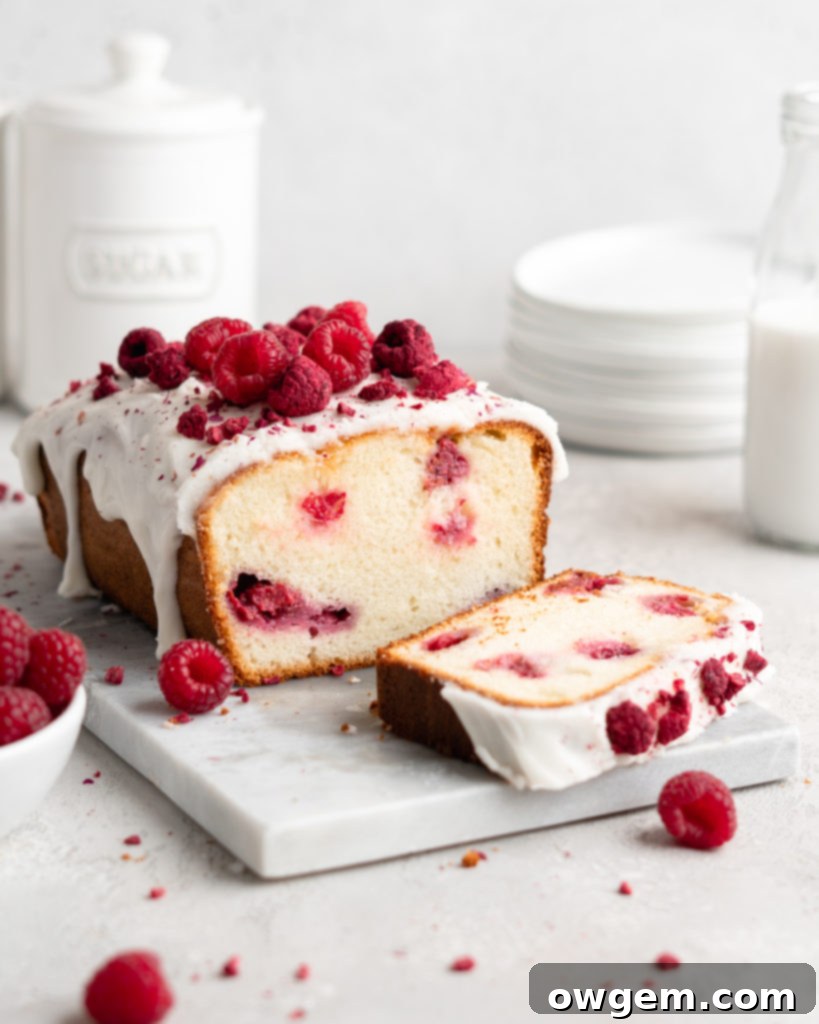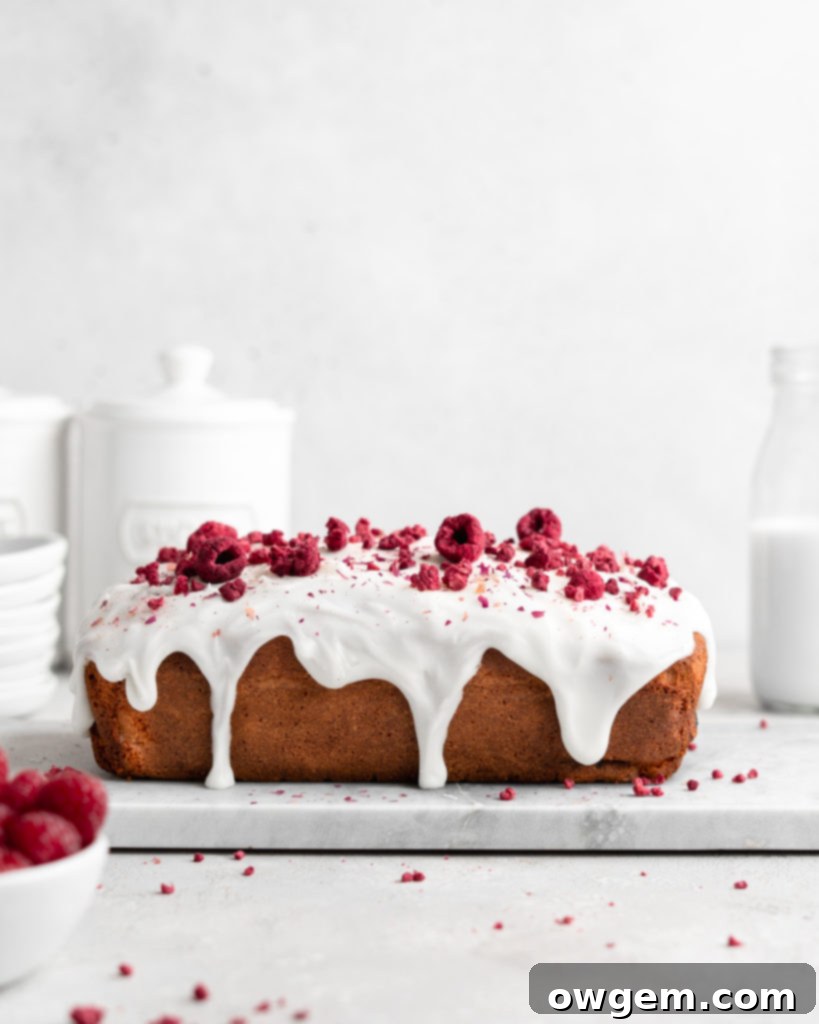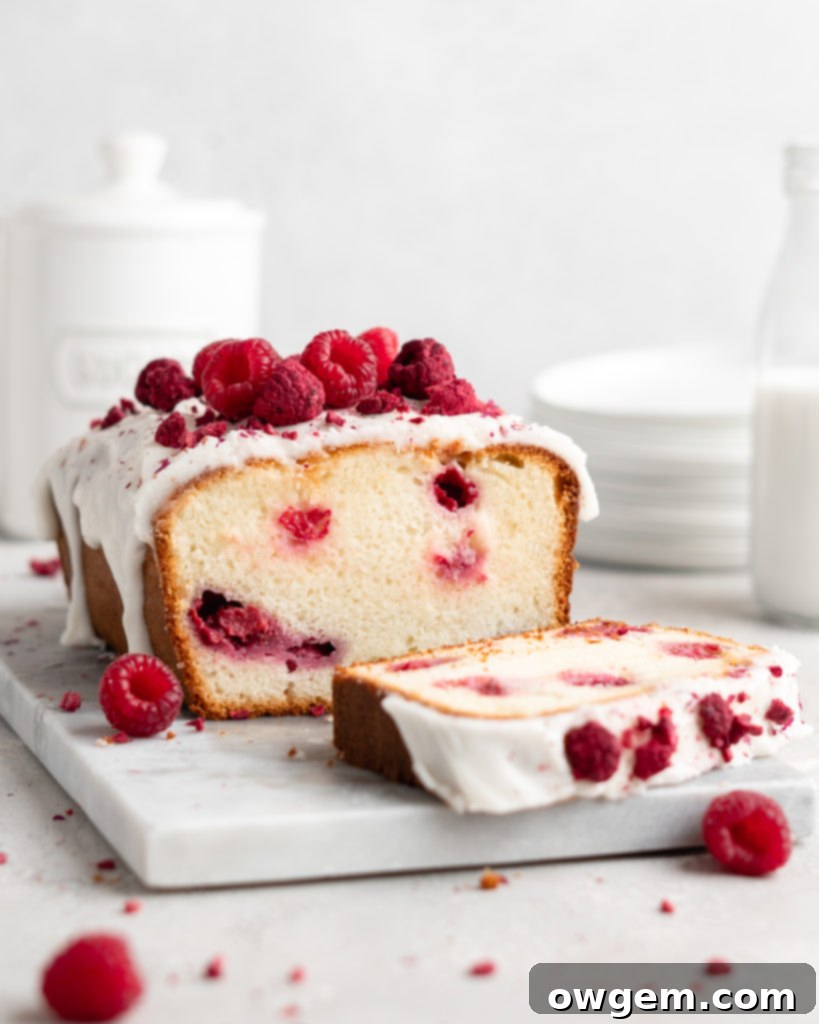Indulgent Raspberry Rose Yogurt Loaf Cake: Your Guide to a Perfectly Moist & Flavorful Dessert
Experience a symphony of flavors with this exquisite Raspberry Rose Yogurt Loaf Cake. Brimming with the vibrant sweetness of fresh raspberries and infused with a delicate floral aroma from rosewater, this cake is more than just a dessert; it’s a celebration. The inclusion of yogurt in the batter ensures an incredibly moist, tender crumb, beautifully complemented by a subtle tang that perfectly balances the sweetness. Whether you’re planning a romantic Valentine’s Day treat, a special occasion, or simply craving a delightful homemade indulgence, this loaf cake promises ease of preparation and unforgettable taste. Its quick assembly and relatively short baking time mean you can spend less time in the kitchen and more time savoring every delicious bite with your loved ones.
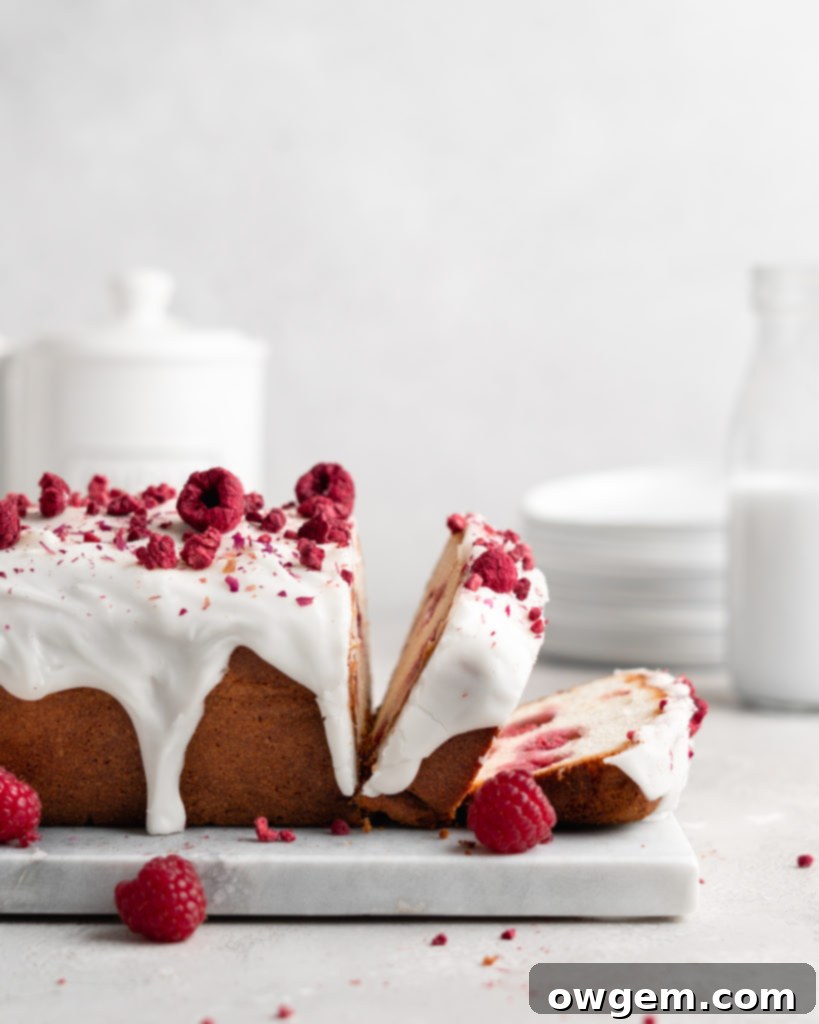
A Sweet Gesture: Perfect for Valentine’s Day and Beyond
This Raspberry Rose Yogurt Loaf Cake debuted as a delightful Valentine’s Day Recipe, and it continues to be a favorite for its charming blend of flavors and simple execution. My philosophy for baking for special occasions, especially those focused on connection, is to keep things effortless yet impressive. You shouldn’t have to wrestle with complicated techniques or lengthy ingredient lists when your goal is to enjoy precious moments. This loaf cake perfectly embodies that principle. It’s designed to be a stress-free baking project, allowing you to create something truly special without feeling overwhelmed. The batter comes together in approximately 20 minutes, and the cake bakes to golden perfection within an hour, filling your home with an inviting aroma. Even the elegant rosewater glaze is a breeze to whip up, taking mere minutes. This makes it an ideal choice for a romantic breakfast, a thoughtful gift, or a lovely dessert to share. While perfect for Valentine’s Day with its romantic rose notes, its universally appealing flavors make it suitable for Mother’s Day, bridal showers, spring gatherings, or simply a cozy afternoon tea. Its understated elegance and vibrant taste ensure it will be a hit no matter the occasion.
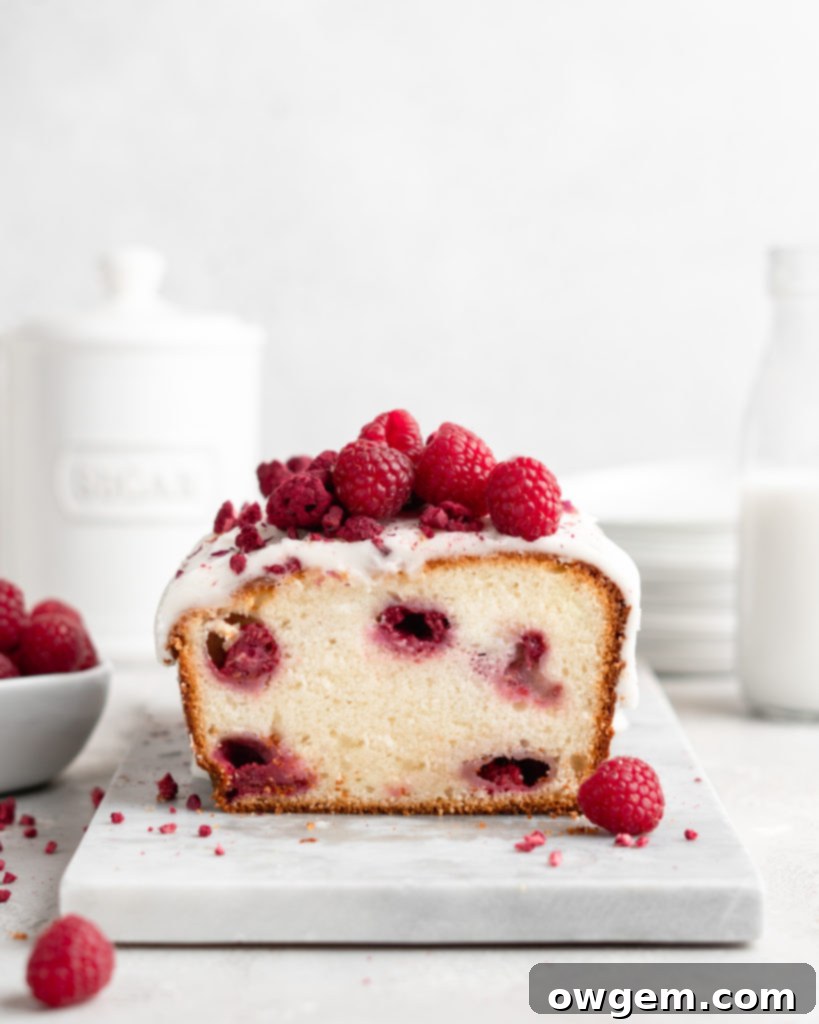
The Secret to Supreme Moisture: Oil vs. Butter in Loaf Cakes
When you glance at this recipe for the Raspberry Rose Yogurt Loaf Cake, you might notice a key difference from many traditional cake recipes: the absence of butter, replaced by oil as the primary fat. Now, before you question this choice, allow me to explain why this seemingly minor alteration is a game-changer for texture and ease! First and foremost, convenience is a major factor. Using oil eliminates the need to plan ahead and soften butter to room temperature – you can simply grab your preferred oil and start baking immediately. This cuts down on prep time and makes spontaneous baking much more feasible. But the advantages of oil extend far beyond mere convenience. In most cake recipes, oil consistently delivers a superior texture, resulting in a cake that is remarkably moister and more tender. This phenomenon can be attributed to the way oil interacts with other ingredients, particularly flour.
Oil is a liquid at room temperature, which allows it to more effectively coat and encapsulate the flour molecules compared to solid butter. This superior encapsulation creates a better lubrication effect within the batter, which in turn minimizes gluten formation. Less gluten development means a more tender crumb, preventing the cake from becoming tough or dry. While butter certainly imparts a rich, distinctive flavor in many baking applications, in a recipe like this Raspberry Rose Yogurt Loaf Cake, which is already bursting with bright, fruity, and floral notes, the nuanced flavor of butter isn’t truly missed. The vibrant raspberries, tangy yogurt, and aromatic rosewater provide ample complexity and depth, making the oil an uncompromised choice for achieving that coveted moist and tender texture. It’s a win-win situation: easier prep and a more delicious, tender cake!
For this recipe, a neutral-flavored oil such as vegetable oil, canola oil, or grapeseed oil is ideal, as it won’t compete with the delicate flavors of raspberry and rose. Olive oil, while delicious in certain contexts, might be too strong for this particular cake. The goal is to let the fruit and floral notes shine, and a neutral oil allows them to do just that while providing unparalleled moisture.
The Tangy Secret: How Yogurt Elevates This Loaf Cake
Another star ingredient in our Raspberry Rose Yogurt Loaf Cake is, as the name suggests, yogurt. Its inclusion is not just for flavor, but also for its remarkable ability to contribute to the cake’s exquisite texture. Yogurt adds a delightful tanginess that beautifully complements the sweetness of the raspberries and the subtle floral notes of rosewater. This acidic component also works wonders with the baking powder, activating it more efficiently and leading to a higher, more tender rise. Moreover, yogurt’s moisture content is higher than that of milk or buttermilk, which means it helps keep the cake incredibly moist and prevents it from drying out over time. It contributes to a wonderfully fine and even crumb that truly melts in your mouth.
For the best results, use full-fat plain yogurt. The fat content contributes to a richer flavor and a more luxurious texture. Avoid non-fat or Greek yogurt varieties unless specified, as their different consistencies and fat levels can alter the final outcome of the cake. If you only have Greek yogurt on hand, you might need to thin it slightly with a touch of milk to achieve a consistency similar to regular plain yogurt, but it’s always best to stick to the recommended full-fat plain yogurt for consistency in baking results.
Crafting Your Raspberry Rose Yogurt Loaf Cake: A Simple Guide
Creating this Raspberry Rose Yogurt Loaf Cake is a straightforward process, even for novice bakers. The key to its success lies in following a few simple steps to ensure the batter comes together perfectly for a moist and tender result.
1. Beat Eggs and Sugar to Perfection: Begin by adding your eggs, granulated sugar, vanilla extract, and a measure of fragrant rosewater into the bowl of your stand mixer. Using the whisk attachment, beat these ingredients together on high speed for approximately 3-4 minutes. This crucial step incorporates a significant amount of air into the mixture, resulting in a light, fluffy, and visibly tripled volume. This aerated base is fundamental for a tender cake, as it contributes to the cake’s lift and delicate crumb structure.
2. Incorporate the Oil for Unmatched Moisture: Reduce the stand mixer speed to medium-low. While the mixer continues to run, slowly and steadily drizzle in the vegetable oil. The slow addition allows the oil to emulsify properly with the egg mixture, preventing separation. Once all the oil has been added, continue beating the mixture for another 30 seconds to ensure it is thoroughly combined and homogenous. This creates a stable base for the remaining ingredients.
3. Whisk Together the Dry Ingredients: In a separate, medium-sized mixing bowl, combine the all-purpose flour, baking powder, and a pinch of salt. Whisk these dry ingredients together thoroughly. This ensures that the leavening agent (baking powder) and salt are evenly distributed throughout the flour, which is vital for an even rise and consistent flavor in your loaf cake. Skipping this step can lead to pockets of baking powder and an uneven texture.
4. Alternate Wet and Dry Ingredients for Optimal Batter: Now, it’s time to bring everything together. With the stand mixer on its lowest speed, begin by adding about one-third of your whisked dry ingredients to the wet mixture. Beat until just combined – overmixing at this stage can develop gluten, leading to a tough cake. Next, add half of the plain yogurt and mix until just incorporated. Continue this alternating pattern, adding the remaining dry ingredients in two more additions, each followed by half of the remaining yogurt, finishing with the final portion of dry ingredients. This method helps maintain a tender crumb. Finally, gently fold in the fresh raspberries using a spatula. Be careful not to crush them too much; just enough to distribute them evenly throughout the batter.
5. Prepare, Bake, and Cool: Pour the beautifully speckled Raspberry Rose Yogurt Loaf Cake batter into your prepared 9×5-inch loaf pan. Ensure the pan has been greased and floured, or lined with parchment paper, to prevent sticking. Place the loaf pan into a preheated oven and bake for approximately 1 hour, or until a wooden skewer or toothpick inserted into the center comes out clean. Once baked, remove the loaf cake from the oven and allow it to cool in the pan for about 10-15 minutes before transferring it to a wire rack. It is absolutely crucial that the Raspberry Loaf Cake cools completely before you apply the glaze. Attempting to glaze a warm cake will result in the glaze melting and running off, rather than setting into a beautiful, opaque coating.
Elevating the Experience: Decorating Your Raspberry Rose Yogurt Loaf Cake
The final flourish for this delightful Raspberry Rose Yogurt Loaf Cake is a simple yet elegant rosewater glaze, specifically designed to amplify the cake’s delicate floral undertones. My preferred glaze for this cake is opaque and wonderfully thick, creating a beautiful contrast against the cake’s texture and holding its shape for a visually stunning finish. To achieve this desired consistency, the trick is to use a very minimal amount of liquid – just enough to transform the confectioners’ sugar from a powdery state into a smooth, pipeable mixture. This means the glaze will be quite thick, possibly even thicker than traditional buttercream, and certainly not pourable. You’ll likely need to either pipe it gracefully onto the cooled raspberry rose loaf cake or carefully spoon it and spread it with a knife or spatula. This thicker consistency ensures a beautiful presentation that sets without dripping.
While this thick glaze is undeniably sweet, it balances perfectly with the cake’s tangy and fruity notes. However, if you prefer a thinner, more pourable glaze that drapes rather than holds its shape, simply add a bit more water, a teaspoon at a time, until you reach your desired consistency. Keep in mind that a thinner glaze may not set as firmly or provide the same visual impact. To further enhance the cake’s aesthetic appeal and add textural interest, I love to decorate the finished loaf with a sprinkle of vibrant freeze-dried raspberries, which offer a delightful crunch and intense fruity flavor. Edible rose petals are another fantastic option, adding a touch of sophisticated elegance and reinforcing the rose theme. You could also add a dusting of confectioners’ sugar for a simpler, classic look. Remember, the presentation is part of the experience, so feel free to get creative!
Customizing Your Creation: Substitutions and Alterations
One of the beauties of this Raspberry Rose Yogurt Loaf Cake recipe is its flexibility. Feel free to experiment with these simple substitutions to tailor it to your preferences or what you have on hand:
- Yogurt Alternatives: For a slightly different tangy profile, sour cream or buttermilk can be used in place of plain yogurt. Both will still contribute to a moist crumb, though buttermilk might require a slight adjustment in liquid quantity due to its thinner consistency.
- Frozen vs. Fresh Raspberries: While fresh raspberries are highly recommended for their vibrant flavor and texture, frozen raspberries can absolutely be used. If using frozen, do not thaw them beforehand. Gently fold them into the batter directly from the freezer to prevent them from bleeding too much color into the cake.
- Different Berries: If raspberries aren’t available or you prefer another fruit, try blueberries, chopped strawberries, or a mix of berries for a different fruity twist.
- Floral Essence Variations: Rosewater provides a unique and elegant floral note. If you’re not a fan of rose, or want to try something different, consider substituting it with almond extract for a nutty depth, or a touch of orange blossom water for a different kind of floral aroma.
- Dairy-Free Options: To make this loaf cake dairy-free, substitute the plain yogurt with a full-fat dairy-free yogurt alternative (such as coconut or almond-based yogurt). Ensure it is plain and unsweetened.
Frequently Asked Questions About Loaf Cakes
Before you dive into baking this delightful Raspberry Rose Yogurt Loaf Cake, here are some common questions and helpful tips to ensure your success:
- How do I store this loaf cake? Once completely cooled, store the loaf cake in an airtight container at room temperature for up to 3-4 days. If it’s particularly warm or humid, or if you plan to keep it longer, refrigerating it will extend its freshness. Bring it back to room temperature before serving for the best flavor and texture.
- Can I freeze the Raspberry Rose Yogurt Loaf Cake? Absolutely! Loaf cakes freeze beautifully. Once the cake is completely cooled and unglazed, wrap it tightly in plastic wrap, then again in aluminum foil. Freeze for up to 3 months. To thaw, simply unwrap and let it sit at room temperature for several hours or overnight. You can then prepare and apply the glaze.
- How do I know when the loaf cake is fully baked? The best way to check for doneness is to insert a wooden skewer or toothpick into the center of the loaf. If it comes out clean with no wet batter attached, your cake is ready. If it’s still wet, continue baking in 5-10 minute increments. Keep an eye on the top; if it’s browning too quickly, you can loosely tent it with aluminum foil.
- What kind of loaf pan should I use? A standard 9×5-inch (23×13 cm) loaf pan is perfect for this recipe. You can use metal or glass. If using a darker metal pan, you might need to slightly reduce the baking temperature or keep a closer eye on it, as dark pans absorb more heat. Always grease and flour the pan, or line it with parchment paper for easy removal.
- Can I use dried rose petals in the batter? While edible rose petals are wonderful for decoration, it’s best to stick to rosewater for infusing the cake with rose flavor. Dried rose petals can become chewy or bitter when baked into the batter.
With these tips in mind, you’re all set to create a magnificent Raspberry Rose Yogurt Loaf Cake that will impress and delight!
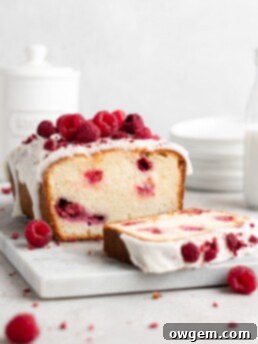
Get the Recipe:
Raspberry Rose Yogurt Loaf Cake
Pin
Rate
Ingredients
Raspberry Rose Yogurt Loaf Cake
- 2 ½ cups (300g) All Purpose Flour,, measured correctly †
- 1 ½ tsp Baking Powder
- 1/2 tsp Salt
- 1 ½ cup Sugar
- 3 Eggs
- 2 tsp Rosewater
- 1 tsp Vanilla
- 3/4 cup Vegetable Oil
- 1 cup Plain Yogurt, (do not use nonfat)
- 1 cup Fresh Raspberries
Rosewater Glaze
- 1 ½ cups Confectioners Sugar
- 1/2 tbsp Vegetable Oil
- 2-4 tbsp Boiling Water
- 1-2 tsp Rosewater
- Pinch of Salt
Equipment
-
Stand mixer
Instructions
Raspberry Rose Yogurt Loaf Cake
-
Preheat oven to 350°F, and prepare a 9×5” loaf pan with oil and parchment. In a medium to large sized mixing bowl, add the flour, baking powder, and salt, then whisk together to combine.
-
In a stand mixer fitted with paddle attachment, add eggs, sugar, rosewater, and vanilla. Beat on high for around 5 minutes, the mixture should look thick, fluffy, and be tripled in volume. Then, slowly drizzle in the oil. After all the oil has been added, beat for an additional minute.
-
On low, add the dry mixture to the stand mixer in 3 additions, alternating with the yogurt in between. Beat only until the batter becomes smooth. Fold in the raspberries.
-
Add the batter to the loaf pan, then bake in the oven for around 1 hour, or until a toothpick comes out clean. Allow loaf cake to cool completely before glazing.
Rosewater Glaze
-
Add all the ingredients into a bowl, and whisk well to combine. Pour or pipe over the cooled loaf cake to glaze.
